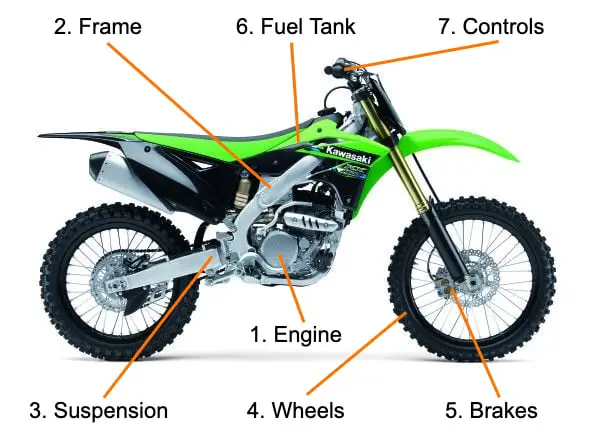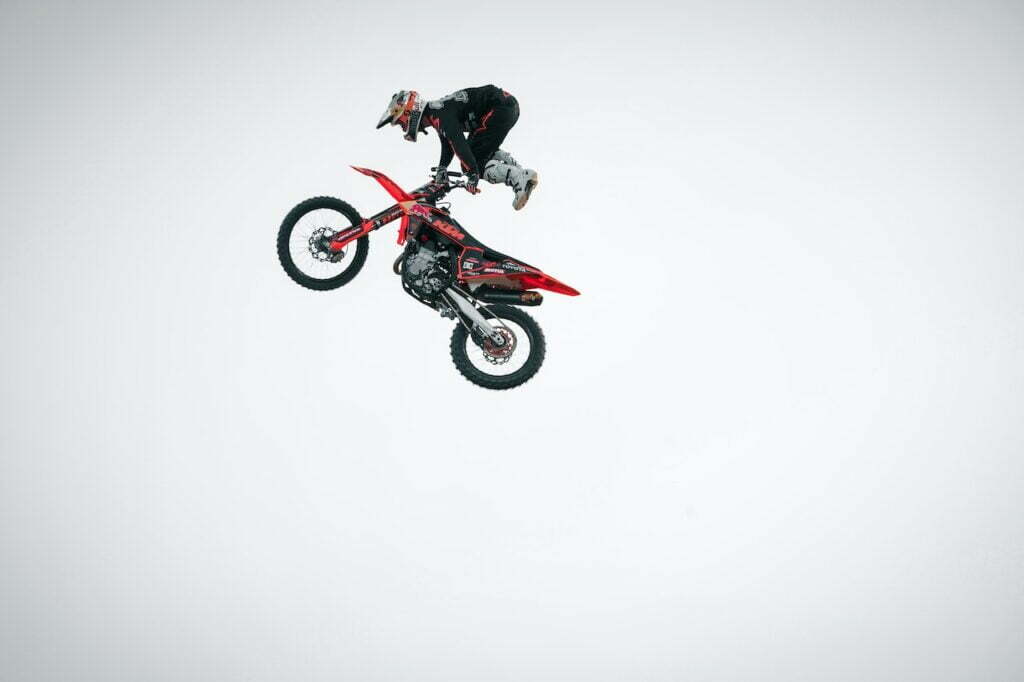Dirt bikes come in all shapes and sizes, and the weight of a dirt bike is an important factor to consider when selecting the right one for you.
Knowing the basics of dirt bike weights can help you make an informed decision that will keep you safe and comfortable on your ride.
An average dirt bike weighs around 215 pounds. Dirt bikes weigh from a minimum 120 pounds to a maximum of 250 pounds. The weight of a dirt bike is a variable factor determined by the make, model and size. The weight will also vary based on the specifications of the bike and any modifications.
Understanding the Basics of Dirt Bike Weights
Before we embark on a deep dive into what factors affect the weight of your dirt bike, we need to cover some basics.
You must have heard terms like “dry weight” and “curb weight” thrown around the forums and discussion boards.
Curb weight and dry weight are terms used to describe the weight of a vehicle or motorcycle.
Curb weight refers to the total weight of a vehicle or motorcycle with all its standard equipment, liquids (fuel, oil, coolant), and a full tank of fuel, but without any passengers or cargo.
Dry weight refers to the total weight of a vehicle or motorcycle with all its standard equipment, but without any liquids (fuel, oil, coolant), passengers, or cargo.
It represents the minimum weight of a vehicle or motorcycle and does not take into account the weight of fluids and fuel.
Both curb weight and dry weight are important measurements for determining the performance and fuel efficiency of a vehicle or motorcycle, as well as for comparing the weight of different models and specifications.
How Much Does an Average Dirt Bike Weigh
The average weight of a dirt bike depends on the type and model of the bike, but as a general rule, most dirt bikes weigh between 200-300 pounds.
The exact weight can vary based on factors such as engine size, suspension components, frame material, and accessories.
A smaller dirt bike, such as a mini bike, may weigh around 70-120 pounds, while a larger motocross bike may weigh around 220-240 pounds.
Please note that these are rough estimates and the actual weight may vary based on individual models and specifications.
Factors that Influence Dirt Bike Weight
Let’s take a closer look at what determines the overall weight of your dirt bike.
Engine size: larger engines tend to weigh more than smaller ones, as they have more components and require more materials to build.
Frame material: dirt bikes can have a steel, aluminum, or carbon fiber frame, and the material used can impact the weight of the bike. Steel frames are usually the heaviest, while carbon fiber frames are the lightest.
Suspension components: dirt bikes with more advanced suspension systems may weigh more than those with basic suspension, as they simply have more components.
Accessories: remember that all additional accessories such as handguards, foot pegs, skid plates, extra lights and luggage racks add to the overall weight of the bike, even though each individual accessory doesn’t seem heavy by itself.
Battery: larger dirt bikes tend to use batteries with higher capacity, which are heavier than batteries of smaller bikes (thanks, Cpt. Obvious).
Wheel size: as with many other components, larger wheels weigh more than smaller ones, simply because they have more metal in them and use larger tires. Choosing a lighter alloy wheel will save you bike weight but will have a higher price tag.
Fuel tank: larger fuel tanks tend to be heavier than smaller ones (duh). More fuel = more weight. A lightweight fuel tank can help to reduce the overall weight of the bike.
Manufacturing process: different manufacturers may have different methods of construction that can impact the weight of the bike, such as the use of lighter materials or more efficient manufacturing processes.
Design: the overall design of the dirt bike, including the shape and size of the air box, brake system and other components, can impact the weight of the bike.
Dirt bike weight by part

- Engine: heaviest component, weighs around 50-100 pounds for a typical dirt bike
- Frame: typically weighs around 30-50 pounds
- Suspension components (forks, shock absorbers): typically weigh around 10-20 pounds each
- Wheels and tires: typically weigh around 15-25 pounds for a set of two
- Brake system (rotors, calipers, master cylinder): typically weigh around 5-10 pounds
- Fuel tank: typically weighs around 5-10 pounds
- Handlebars and controls: typically weigh around 2-5 pounds
Once again, these are rough estimates and the actual weight of each component can vary based on individual models and specifications.
Types of Bikes and their Respective Weights
In case you are curious, here are some of the most common types of dirt bikes and their average weight ranges.
| Bike Type | Typical Engine Size | Typical Weight |
| Motocross | 250cc – 450cc | 220 – 240 pounds |
| Trail | 125cc – 300cc | 200 – 225 pounds |
| Enduro | 250cc – 650cc | 220 – 265 pounds |
| Dual Sport | 250cc – 650cc | 225 – 295 pounds |
| Mini / Pit | 50cc – 125cc | 70 – 120 pounds |
Maximum Load Capacity for a Dirt Bike
The maximum load capacity of a dirt bike depends on various factors such as the bike’s make and model, engine size, suspension, and other components.
However, as a general rule, most dirt bikes are designed to handle a combined weight of the rider and gear of around 300-350 pounds.
It is important to note that exceeding the manufacturer’s recommended weight limit can result in reduced performance, handling, and overall safety.
I strongly advise to refer to the owner’s manual or consult the manufacturer for the specific weight limit of a dirt bike.
Wrapping up
There are many factors affecting dirt bike weight, predominantly the individual weight of each part, the design of the bike itself and the manufacturing process.
The two ways of measuring dirt bike weight are called “dry weight” and “curb weight” – the former referring to an empty bike just out of the factory and the latter referring to a bike ready to go with all its fluids, lubricants and a full tank of gas.
The heaviest part of the dirt bike is usually its engine, followed closely by the frame. Other components weigh less than these two.
Finally, we learned that an average dirt bike can have a load capacity of around 300-350 pounds, which is suitable for the majority of riders out there.
Well, there you go! Now you know a lot more about dirt bike weights and what factors affect them so you can make conscious decisions when it comes to choosing a dirt bike or adding modifications to it.



